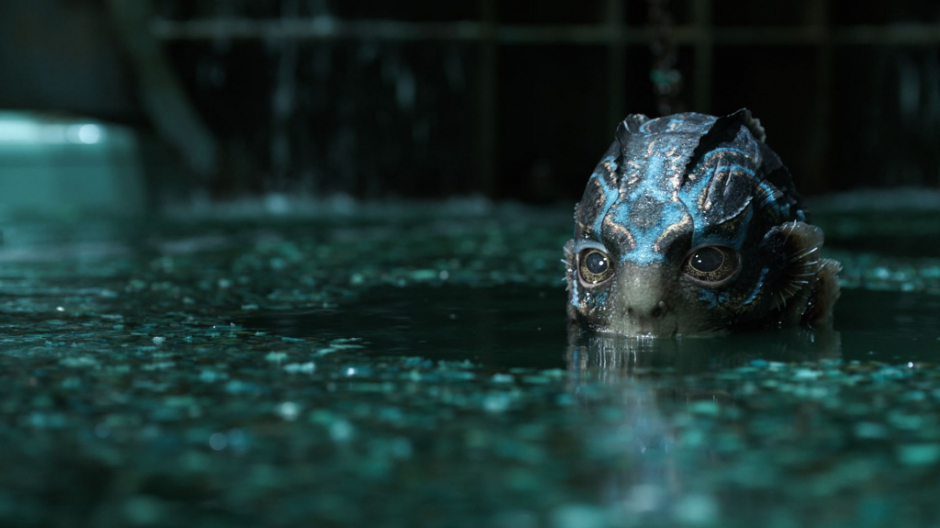To be swept up in the current of Guillermo Del Toro’s The Shape of Water is to be bathed in the peculiar comfort afforded by the dark fairy-tale genre: there will be horrors, there will be monsters, but there will also be a magic which is on our side and will carry us safely back to shore. Here, the magic is an ancient sea-god, but it also the fantasy of cinema, of which Del Toro is as ardent a disciple as he is with myth and folklore. This is perhaps his most indulgent film, his most cheery and cheesy, but it is unashamedly so and from the very first frame it invites us to indulge too as the camera swims through a flooded house and seeks out our slumbering princess. As Del Toro often does, we are asked to be children again, to let ourselves succumb to the silliness of the fairies, but as soon as our princess disrobes and starts masturbating in a bath, we are thrown back into adulthood. And this is where Del Toro likes to have us; poised between child and adult, gleeful but unnerved. It is the same state we were put in for Pan’s Labyrinth, and it has not been bettered since – but The Shape of Water gives it a fair old go.
Our fairy-tale princess is Elisa (Sally Hawkins), a mute cleaner who lives in a poky but cosy apartment above a cinema and watches classic dance movies on her small TV with her flatmate Giles (Richard Jenkins). The ‘old movies’ mise-en-scene is something of a well-worn cliché now – see previous recent Oscar luvvies La La Land and The Artist for just two examples – but Del Toro earns the aesthetic by infusing his film with a richness of its own, punctuated by many moments of unabashed absurdity. As a result, there is much to enjoy and delight in here, and while the story itself is somewhat predictable, it is constructed of gorgeous scenes which linger long after the final visual flourish.
Our setting is early sixties Baltimore where we find Elisa working inside a clandestine government facility run with demonic intensity by the masochistic Richard Strickland (the ever-terrifying Michael Shannon). The facility obtains a new ‘asset’, a sea-god figure played by Doug Jones, who is essentially the Creature from the Black Lagoon with a grand chest of muscles, a ferocious bite when angered and a tender heart for the innocent cleaner who feeds him eggs. There is some sort of vaguely stated ‘science’ underway at the facility where background scientists press buttons and pull levers to help thwart the Red Threat and speed the US towards winning both the space race and the cold war. Much of the detail of this is kept at an awkward arms-length because it never really quite fits the crux of the plot (somehow the sea-god creature will help astronauts breathe better in outer space?) but all this is whipped past as irrelevance. We are in fairy-tale land; the baddies want to hurt the monster and the goodies want to save it. And so plucky Elisa fashions together a heist to get the sea-god out and stop the magic from being drowned. And we are with her every step of the way.
But at its core, this film is a romance. A cross-species love quickly blooms between Elisa and the sea-god, and here is Shape of Water’s most remarkable achievement. This could so easily have been laughable, or just too plain weird, but the combination of the fabulous design of the creature and the loveable performance by Hawkins creates a romance which really works. Del Toro doesn’t even shy away from the biology of the coupling, wrapping the question up in fantastical imagery and a small moment of cheeky humour. By the time, therefore, that we hurry towards the drama of the ending, there is no question of what we want for Elisa and her weird lover and fuzzy emotions are driven sky high.
There are many more elements to admire. Elisa’s muteness is played with affection and tenderness and, in her communications with the sea-god, her disability is given a transformative agency rather than the misery of sympathy. Del Toro maintains his skills for grisly horror and violence, making us squirm almost as often as he makes us smile. In the supporting cast, Michael Stuhlbarg (very much the unsung hero of this year’s Oscar movies appearing in both The Post and Call Me by Your Name) gives a fine performance of deception and desperation as chief scientist Dr. Hoffstetler, a man with an uneasy secret. Elsewhere, Octavia Spencer does a decent job of squeezing character out of the somewhat stereotyped figure of Zelda, Elisa’s co-worker and confidante, and Richard Jenkins steals a few scenes with his warm portrayal of Elisa’s gay flatmate Giles. But the film belongs to Hawkins who infuses Elisa with a rich spectrum of emotions to create a silent heroine whose hands and eyes shout louder than any voice, a dreamer who sees the tides of a better world and fights tooth and nail to get there.
Dive below the surface of The Shape of Water and perhaps there’s not too much more to see. There are some plotting wobbles, a couple of fantastical indulgences too far, and the story itself is a river we’ve paddled down many times before. It won’t quite be this generation’s E.T. – the classic movie it most resembles – but it is by no means a film that can be easily dismissed. Del Toro delivers an elegant, enthusiastic and elegiac movie which revels in the fantasies of both fairy-tale and the cinema in equal measure. It has a classic feel; light on pretension, generous in spirit and prepared to take gentle fantastical risks. It all adds up to a gutsy feel-good action romance with a geeky indulgence for monsters. Dive in and let it soak through your gills.
by David Hartley

